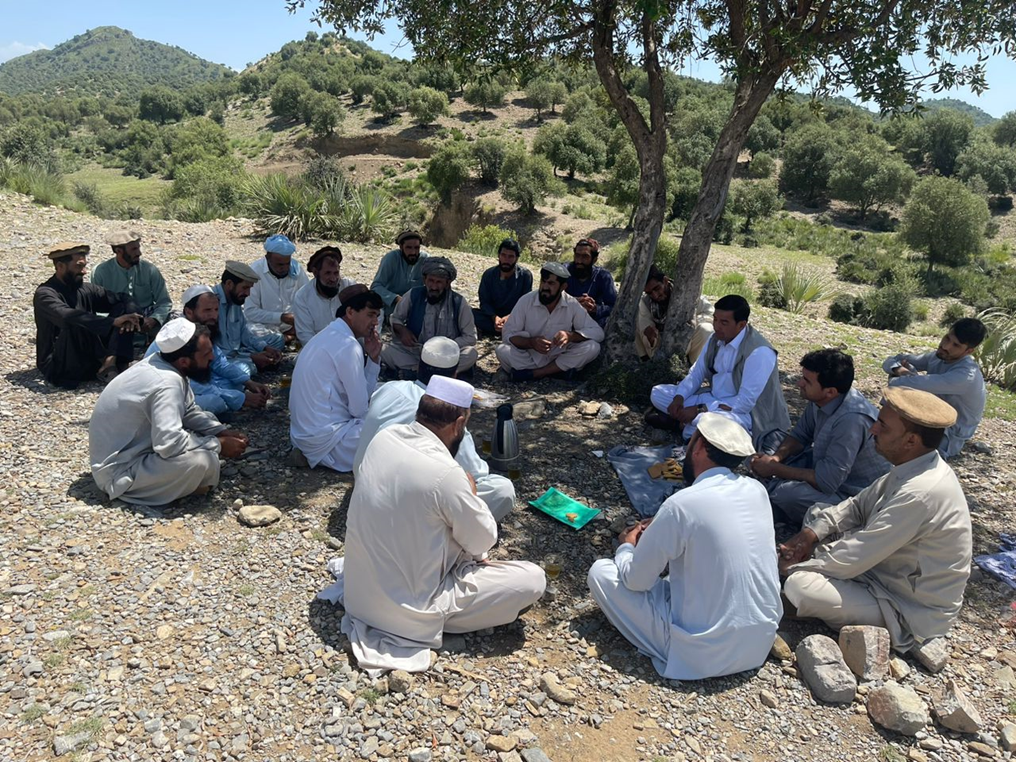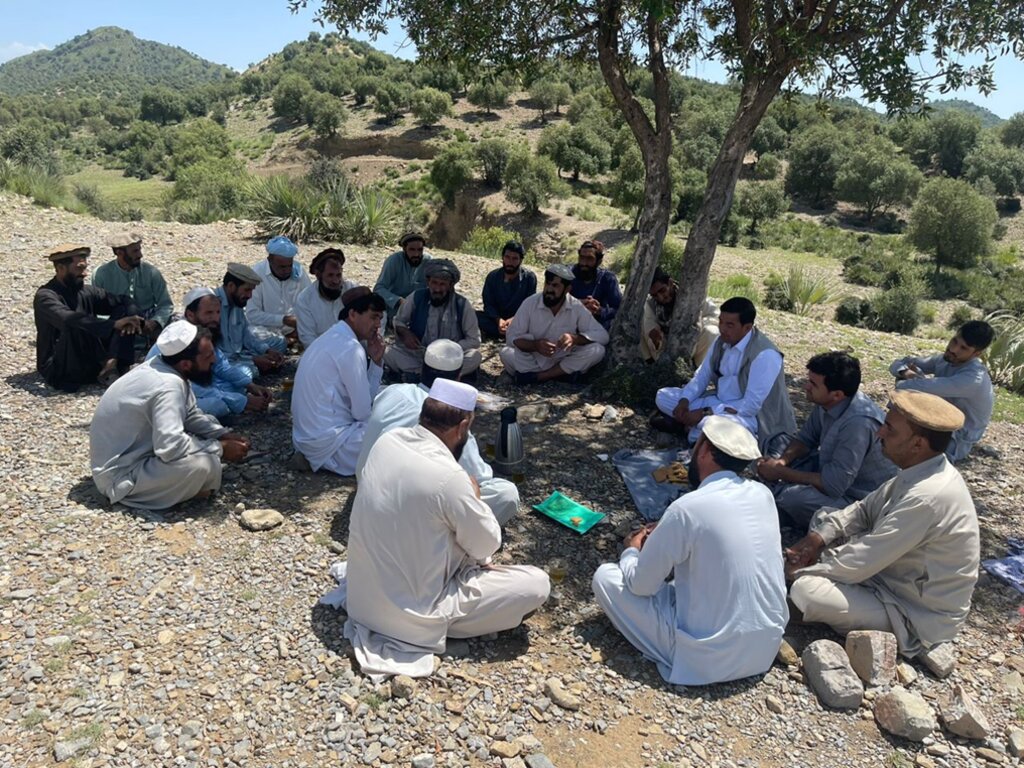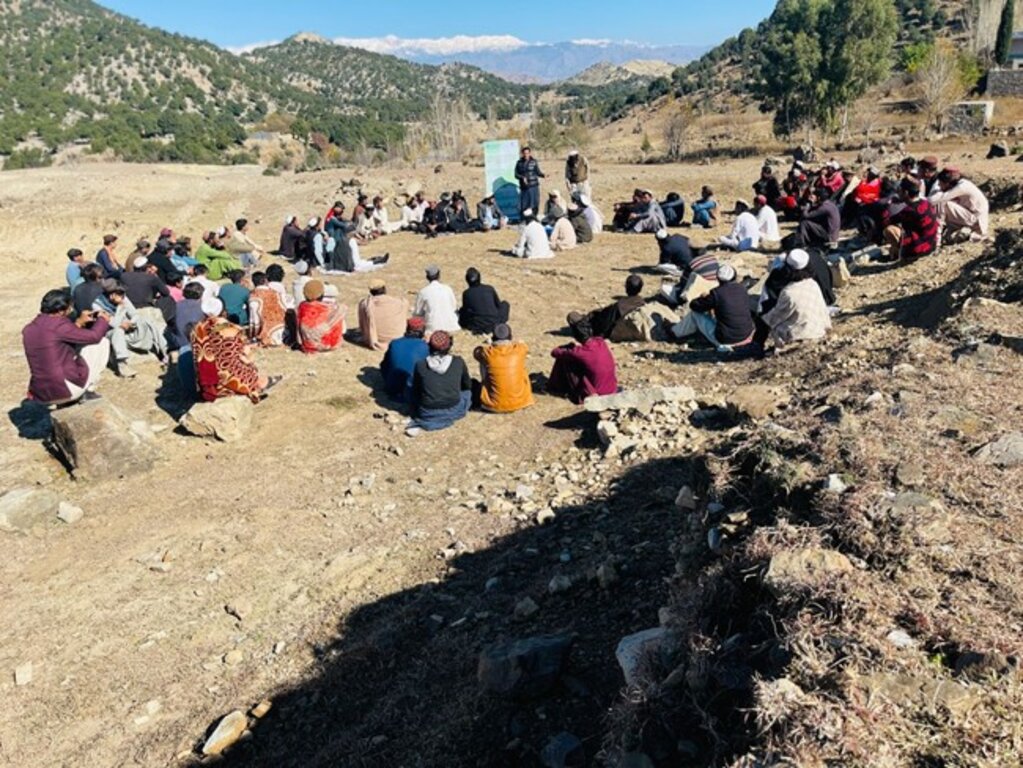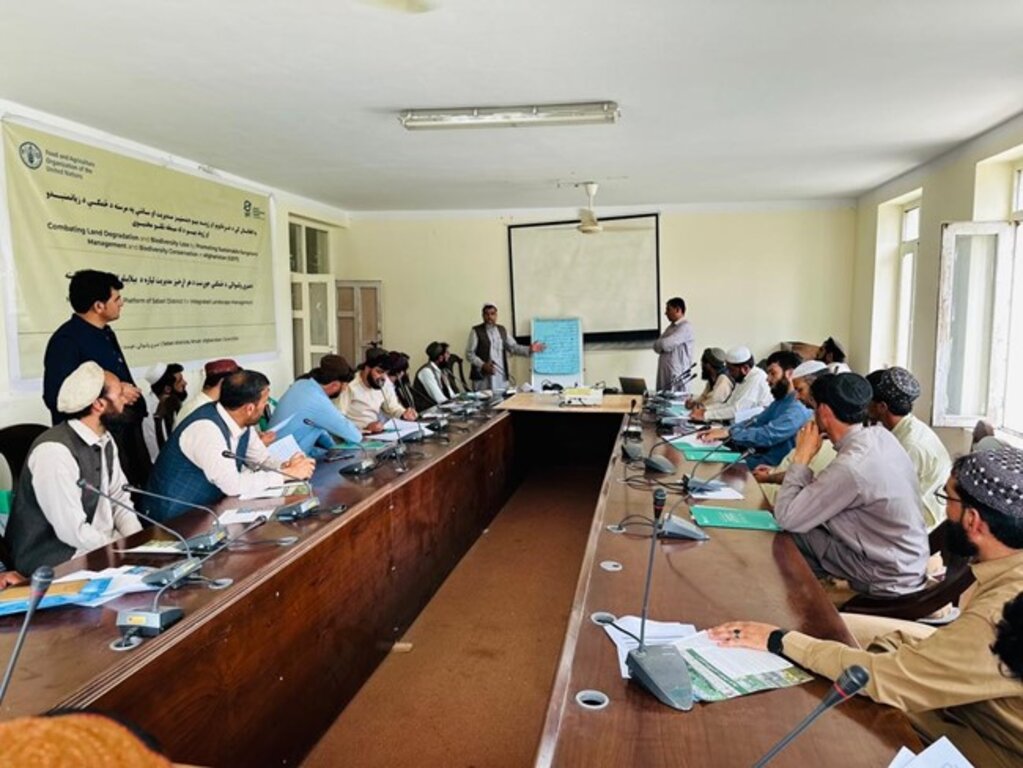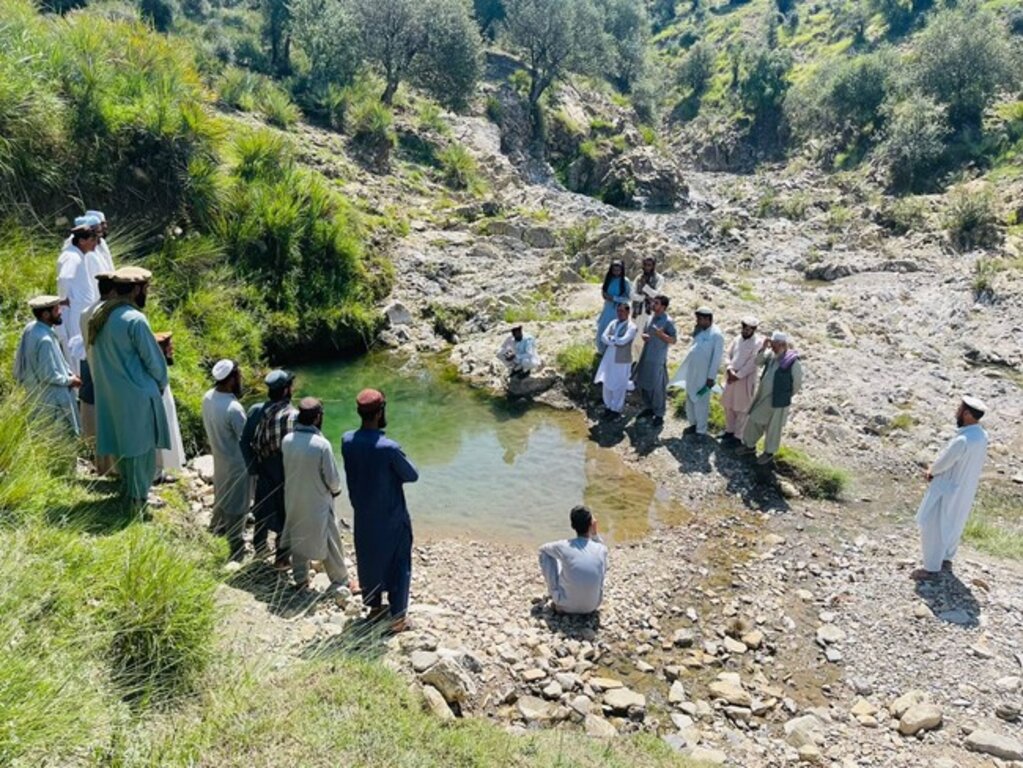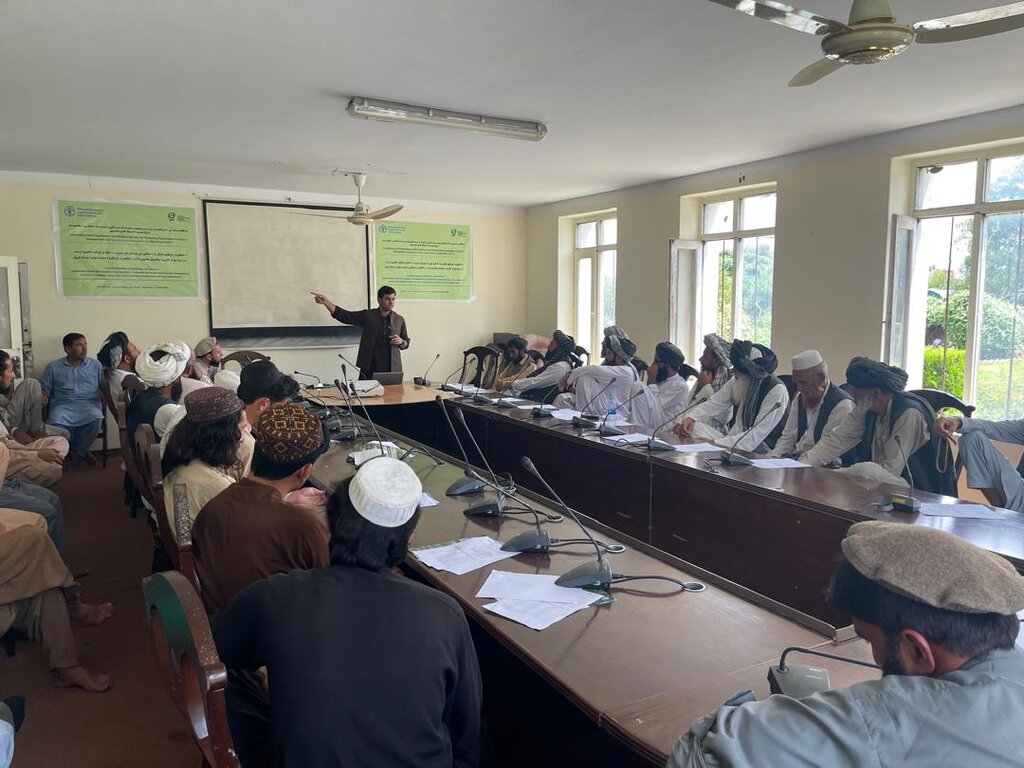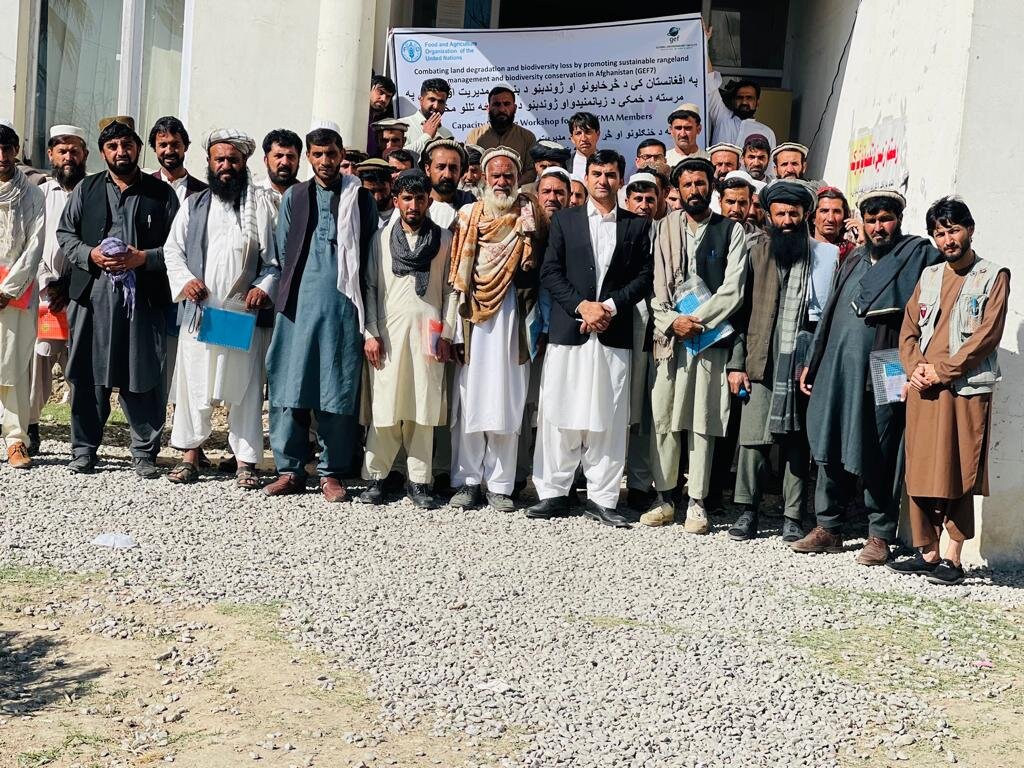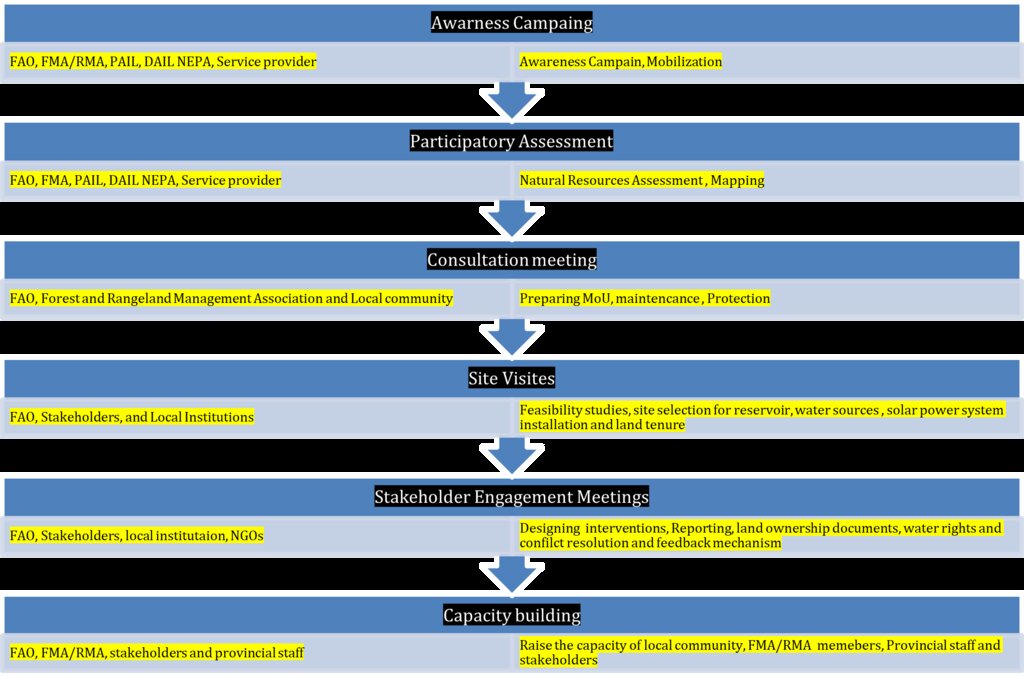Stakeholder collaboration for building Learning Site for landscape restoration [Afeganistão]
- Criação:
- Atualização:
- Compilador/a: Mohammad Arif
- Editores: Afghanistan Safi, Megha bajaj, Mohammad Aslam Hasand
- Revisores: Rima Mekdaschi Studer, Illias Animon, Muhammad Ishaq Safi
دځمکې مخینی د بیارغونې په موخه دښکیلو اړخونو د ګډو هڅو سره د زده کړی ساحی رامینځ ته کول
approaches_7469 - Afeganistão
Veja as seções
Expandir tudo Recolher tudo1. Informação geral
1.2 Detalhes do contato das pessoas capacitadas e instituições envolvidas na avaliação e documentação da abordagem
usuário de terra:
Muhajir Akbar
+93(0) 797166519
Sparkai Forest and Rangeland Management Association
Stara Mila- Sparkai village- Baak district - Khost-Afghanistan
Afeganistão
Nome do projeto que facilitou a documentação/avaliação da Abordagem (se relevante)
Combating land degradation and biodiversity loss by promoting sustainable rangeland management and biodiversity conservation in AfghanistanNome da(s) instituição(ões) que facilitou(ram) a documentação/avaliação da Abordagem (se relevante)
FAO Afghanistan (FAO Afghanistan) - Afeganistão1.3 Condições em relação ao uso da informação documentada através de WOCAT
Quando os dados foram compilados (no campo)?
21/10/2024
O/a compilador/a e a(s) pessoa(s) capacitada(s) aceitam as condições relativas ao uso de dados documentados através da WOCAT:
Sim
1.4 Referência ao(s) questionário(s) sobre tecnologias da GST
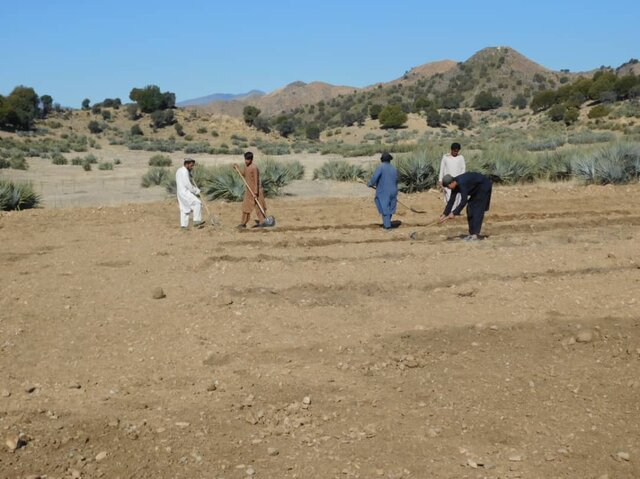
Learning Site to promote Sustainable Land and Forest … [Afeganistão]
The learning site incorporates several key elements of the technology including a solar-powered water lifting system, three reservoirs and an adopted irrigation system. It features demonstration plots for various initiatives, such as tree planting (walnut, almond, pomegranate and mulberry, the cultivation of fodder (alfalfal Mazari palm) and and medicinal plants …
- Compilador/a: Mohammad Arif
2. Descrição da abordagem de GST
2.1 Descrição curta da abordagem
To raise awareness and ensure clear role delineation, a series of consultations were held with the local community, the Forest Management/Rangeland Management (FM/RM) association, and other key stakeholders.
Memorandum of Understanding (MoU) that formally outlined the roles and responsibilities of each party was signed. Additionally, the FM/RM association issued a letter of guarantee to support the establishment of a learning site dedicated to promoting best practices in forest and rangeland management. (e.g. cumin) through community’s own contributions.
2.2 Descrição detalhada da abordagem
Descrição detalhada da abordagem:
For Sustainable Land Management (SLM) and biodiversity conservation in Khost, Afghanistan, we started with awareness campaigns in the districts. This mobilization aimed to introduce the project and Community-Based Natural Resource Management (CBNRM) planning, while identifying potential sites for project implementation.
Following the identification of these sites, we launched another awareness campaign to initiate participatory assessments of local natural resources, including forests and rangelands. This led to the development of CBNRM plans, through which we identified gaps in forest and rangeland management that required improvements and new intervention strategies. We also identified the critical issues of forest and rangeland degradation, as well as the needs of the local community, which allowed us to find alternative livelihood interventions to reduce reliance on natural resources.
We visited multiple sites with water availability near forests and rangelands to select the most suitable locations for our interventions.
Once sites were selected, we developed a Memorandum of Understanding (MoU) outlining the roles and responsibilities of each party involved, including FAO, the Forest and Rangeland Management (FM/RM) Association, and the local government. We also prepared a grant letter to ensure the sustainability and ownership of the project by the FM/RM Association.
After the establishment and completion of interventions at the sites, we conducted capacity-building sessions for the local community, FM/RM Association, nomadic groups, and stakeholders from local institutions. These sessions focused on teaching participants how to restore landscapes, specifically forests and rangelands.
The approach includes awareness campaigns, consultation meetings, participatory assessments, resource mobilization, capacity building, and the establishment of a Memorandum of Understanding (MoU) to ensure sustainability. The aim is enabling the local community, FM/RM Association, and stakeholders (Nomads, District and Provincial Agriculture, Irrigation, and Livestock (DAIL/ PAIL),and the National Environmental Protection Agency (NEPA)) to learn good practices for restoring land and forests while utilizing natural resources sustainably. This also involves enhancing the community's capacity to replicate and scale up similar initiatives. The approach is executed through a community-based traditional system, with contributions from both the project team and local communities.
The FM/RM Association has issued a maintenance grantee letter and hired guards to protect the site. Additionally, efforts are being made to mobilize villagers and nomadic groups to refrain from entering the area and grazing their livestock within the designated restoration site.
Key stakeholders include PAIL, NEPA, district entities, community institutions, and the FM/RM Association. PAIL and NEPA play crucial roles in helping the local community resolve land disputes and facilitating discussions related to land, water rights, and more. The local community and FMA/RMA are essential to the interventions, contributing to maintenance, safeguarding, dispute resolution over land, grazing management, irrigation, and replacing dead plants. FMA/RM Association serves as key stakeholder established by the project providing legal MoU, maintenance letters, and facilitating awareness and mobilization on-site while addressing any issues that arise during implementation. Land users appreciate capacity-building sessions during Focus Group discussions and key informant interviews, awareness-raising initiatives, and their involvement in practical implementation. However, they express concerns about cash contributions due to poverty and unemployment, preferring assistance in other forms.
2.3 Fotos da abordagem
Observações gerais sobre as fotos:
The photos have been taken with low quality smart phone.
2.4 Vídeos da abordagem
2.5 País/região/locais onde a abordagem foi aplicada
País:
Afeganistão
Região/Estado/Província:
Khost
Especificação adicional de localização:
Sparkai Village, Baak district
Comentários:
The approach was implemented in Sparkai Village and by the Sparkai Forest and Rangeland Management Association in Baak District, Khost Province. An awareness campaign was conducted, alongside coordination meetings with all stakeholders. We visited various villages in the district to carry out a participatory assessment of natural resources and identify key sites for forest, rangeland, and watershed management. After a series of consultation and stakeholder engagement meetings, we selected the site and signed a Memorandum of Understanding (MoU) for the establishment of the learning site.
Map
×2.6 Datas de início e término da abordagem
Indique o ano de início:
2023
Caso o ano exato seja desconhecido, indique a data aproximada de início da abordagem:
menos de 10 anos atrás (recentemente)
Ano de término (caso a abordagem não seja mais aplicada):
2024
Comentários:
As part of project outputs, a learning site was to be established within the first year, starting in 2022. However, due to the time required for pre-assessment and participatory assessment, as well as community awareness and mobilization efforts, the identification and selection of a suitable site took longer than anticipated. By June 2023, a site was successfully identified namely Stara Mila in Sparkai Village, Baak District, Khost Province. Several key interventions were completed, including the installation of a solar power lifting system, the construction of reservoirs, and the establishment of demonstration areas for restoration. For moving forward, it is essential to sustain and manage these interventions throughout the project's lifespan. The project plans to hand over the management of these facilities to the local community to ensure ownership and long-term sustainability
2.7 Tipo de abordagem
- Baseado em projeto/programa
2.8 Principais metas/objetivos da abordagem
-Strengthen the skills and knowledge of local communities to effectively adopt solar-powered lift irrigation systems and optimize the use of river resources.
-Enable local communities to sustainably manage and utilize their natural resources, ensuring long-term ecological balance.
-Leverage traditional practices and foster local support to enhance future sustainable natural resource management.
-Actively involve youth in development initiatives, promoting their role in managing natural resources and fostering a sense of stewardship.
-Establish a hub that brings together local communities, stakeholders, and students to learn about land and forest management practices.
-Train local communities and stakeholders on transforming unproductive land into productive agricultural and forest areas, thereby enhancing food security and livelihoods.
-Empower local communities to replicate and put to scale successful land restoration and forest management initiatives, promoting sustainable practices and building community resilience.
2.9 Condição que propiciam ou inibem a implementação de tecnologia/tecnologias aplicada(s) segundo a abordagem
Normas e valores sociais/culturais/religiosos
- Propício
Foster social participation by promoting women's involvement in decision-making processes and integrating traditional mechanisms to enhance community engagement and inclusivity.
Disponibilidade/acesso a recursos e serviços financeiros
- Inibitivo
Local communities involved in forest and rangeland management often face significant challenges due to a lack of financial resources. Unemployment, political crises, and traditional norms can further restrict their access to essential funding and services. These barriers hinder their ability to implement sustainable management practices and improve their livelihoods.
Quadro institucional
- Propício
Forest and Rangeland Management Association (FM/RM A) established
Colaboração/coordenção de atores
- Propício
FM/RM A is key stakeholders in Community-Based Natural Resource Management (CBNRM) activities. Local communities and stakeholders regularly hold coordination meetings to collaborate and contribute to various development projects.
Quadro jurídico (posse de terra, direitos de uso da terra e da água)
- Propício
FMA/RM A serves as a legal entity responsible for managing land tenure and water rights through traditional practices, with support and contributions from government entities.
Governança da terra (tomada de decisões, implementação e aplicação)
- Propício
FMA/RM A and local communities are actively participating in decision-making processes related to land management. Their involvement includes supervision, monitoring, resolving land disputes, implementing policies, and addressing various land-related issues. This collaborative approach ensures that the voices of local stakeholders are heard and considered in all aspects of land governance.
Conhecimento sobre GST, acesso a suporte técnico
- Propício
Local community, FMA/RM A and stakeholders have access to knowledge, skills about SLM and sustainable forest and rangeland management practices.
Carga de trabalho, disponibilidade de força de trabalho
- Propício
This technology has created jobs and provided sufficient manpower to facilitate the implementation of CBNRM interventions.
3. Participação e papel das partes interessadas envolvidas
3.1 Partes interessadas envolvidas na abordagem e seus papéis
- Organizações comunitárias
The Forest and Rangeland Management (FM/RM) Association .
FM/RM Association facilitated awareness campaigns, mobilized communities, conducted participatory assessments, and resolved land and water disputes.
- Especialistas em GST/ consultor agrícola
FAO SLM specialists, community mobilizers, local volunteers, district-level Agriculture, Irrigation and Livestock workers and the National Environmental Protection Officer.
To enhance the roles of stakeholders involved in coordinating forest and rangeland management at district-level, the following should be considered: capacity building, organizing workshops and seminars, facilitating knowledge sharing, improving communication, establishing feedback mechanisms, and fostering community engagement.
- Governo local
Provincial Agriculture, Irrigation, and Livestock (PAIL), the National Environmental Protection Agency (NEPA) were involved at provincial level.
To improve the roles of stakeholders involved at provincial level in coordination of forest and rangeland management, the following should be considered: conflict resolution mechanism, collaborative partnerships and monitoring and evaluation and the utilization and sustainability of the technology.
- Governo nacional (planejadores, responsáveis pelas decisões)
District governor;
District Urban Development and Land.
Facilitated meetings on natural resource management laws and conflict resolution
Caso várias partes interessadas foram envolvidas, indique a agência líder:
FAO-Afghanistan
3.2 Envolvimento do usuários de terra/comunidades locais nas diferentes fases da abordagem
| Envolvimento do usuários de terra/comunidades locais | Especifique quem estava envolvido e descreva as atividades | |
|---|---|---|
| Iniciação/motivação | Automobilização | Local land users FM/RM Association members called for awareness raising campaigns, mobilization, resolving disputes over the land, participating in participatory assessment, feasibility studies, site identification and site selection. |
| Planejamento | Participativo | Local community provided first hand data about the natural resources, indigenous species, for the CBNRM planning. |
| Implementação | Participativo | The FM/RM Association actively engaged in the implementation process by hiring guards for site security, monitoring activities, and providing human resources for interventions. This collaborative approach ensured effective oversight and community involvement. |
| Monitoramento/avaliação | Participativo | Local community and stakeholders supervised and monitored the learning site throughout the implementation and up to completion. They provided a guaranteed letter ensuring the sustainability and ongoing maintenance of the learning site. |
3.3 Fluxograma (se disponível)
Descrição:
The project involved various stakeholders, including the FM/RM Association, Provincial and District Agriculture, Irrigation and Livestock (PAIL/DAIL) departments, the National Environmental Protection Agency (NEPA), and service providers. These organizations participated in awareness campaigns, consultation meetings, participatory assessments, feasibility studies, and site selection.
The FAO technical engineering team designed the solar-powered lifting system and reservoirs, which were implemented through a service provider. Additionally, the FAO team selected forest species for reforestation and demonstration plots. The community, along with the FM/RM association, planted the provided saplings from FAO.
Demonstration plots were prepared, and fencing was installed through a contract with a service provider. The local community and FMA/RMA hired a guard to ensure the site's safety and maintenance.
Key stakeholders, including PAIL, DAIL, NEPA, and district entities, played important roles in meetings, dispute resolution, and providing assistance in accordance with their policies and responsibilities.
3.4 Decisão sobre a seleção de tecnologia/tecnologias de GST
Especifique quem decidiu sobre a seleção de tecnologia/tecnologias a serem implementadas:
- todos os atores relevantes, como parte de uma abordagem participativa
Explique:
All activities, from awareness campaigns to mobilization coordination, participatory assessments, feasibility studies, and decision-making processes, were carried out collaboratively. Every stakeholder actively engaged from the selection phase through implementation to successful completion.
Especifique em que base foram tomadas as decisões:
- Avaliação de conhecimento bem documentado de GST (tomada de decisão baseada em evidências)
4. Suporte técnico, reforço das capacidades e gestão do conhecimento
4.1 Reforço das capacidades/ formação
Foi oferecida formação aos usuários da terra/outras partes interessadas?
Sim
Especifique quem foi capacitado:
- Usuários de terra
- Equipe de campo/consultores
Tipo de formação:
- Em exercício
- Agricultor para agricultor
- Áreas de demonstração
- Reuniões públicas
Assuntos abordados:
Sustainable forest and rangeland management, rotational grazing, integrated landscape management, CBNRM planning, biodiversity conservation, demo plots preparation, reforestation, watershed management climate smart agriculture, pastoralist field school, operation and maintenance of the learning site.
Comentários:
During the project's initiation, the FAO-GEF7 team conducted comprehensive training sessions for a diverse range of participants, including the local community, forest and rangeland management associations, stakeholders, Kuchies (nomads), youths, and women. These training sessions were designed to cover a broad range of topics essential for sustainable resource management and community engagement.
Participants were introduced to the project's objectives, fundamental principles of Natural Resource Management (NRM), Community-Based Natural Resource Management (CBNRM) planning, the establishment of community-based nurseries, mechanisms for receiving and addressing complaints, sustainable practices for managing forests and rangelands, reforestation methods, watershed management strategies, value chains within forest and rangeland ecosystems, integrated landscape management approaches, techniques for biodiversity conservation, measures for controlling grazing activities, practices for rotational grazing, management of demonstration plots, principles of climate-smart agriculture, pastoralist field schools, and the operation and maintenance of the learning site.
Through these training sessions, the project aimed to equip participants with the knowledge and skills necessary to promote sustainable practices, enhance biodiversity conservation, foster community engagement, and ensure the long-term success of the project's objectives.
4.2 Serviço de consultoria
Os usuários de terra têm acesso a um serviço de consultoria?
Sim
Especifique se foi oferecido serviço de consultoria:
- nas áreas dos usuários da terra
- At learning site established by local volunteers, District Agriculture Irrigation and Livestock (DAIL) staff and FAO technical team
Descreva/comentários:
The FAO technical team collaborates with on-site local volunteers in villages, district agriculture, irrigation, and livestock departments, along with Forest and Rangeland Management Associations, to offer crucial advisory services. These services encompass irrigation techniques, maintenance practices, plantation guidance, establishment of demonstration plots, grazing management strategies, reforestation efforts, implementation of rotational grazing methods, mulching practices, as well as land and forest restoration techniques
4.3 Fortalecimento da instituição (desenvolvimento organizacional)
As instituições foram fortalecidas ou estabelecidas através da abordagem?
- Sim, moderadamente
Especifique a que nível (níveis) as instituições foram fortalecidas ou estabelecidas:
- Local
Descreva instituição, papéis e responsabilidades, membros, etc.
The Forest and Rangeland Management (FM/RM) Association, in collaboration with the local community, plays a pivotal role in the sustainable management of natural resources. They serve as a central institution for coordinating contributions and assistance in various development projects in the area. Their responsibilities encompass mobilization of manpower, awareness-raising, participatory assessments, feasibility studies, supervision, maintenance, dispute resolution, and more.
Through a mutually agreed-upon Memorandum of Understanding (MoU), these entities are committed to resolving disputes, providing essential information for data collection, irrigation practices, safeguarding the site, working towards sustainability, maintaining the entire system and site, replacing deceased plants, mobilizing when necessary, controlling grazing activities, promoting the sustainable utilization of natural resources, preparing land for demonstration plots, and establishing forest nurseries.
Especifique o tipo de apoio:
- Financeiro
- Reforço das capacidades/ formação
- Equipamento
Dê mais detalhes:
FAO has supplied saplings, tools, materials, constructed reservoirs and solar power water lifting system and alternative livelihood interventions. They have also conducted capacity-building trainings, on-job trainings, Pastoralist field school trainings, and community engagement for planting saplings. Additionally, they have facilitated on-site activities, mobilization efforts, awareness campaigns, coordination meetings, safeguarding of the forest and rangeland, and encouraged local community involvement. Furthermore, they have actively engaged youths and women in every intervention implementation and have played a vital role in resolving disputes during the implementation process.
4.4 Monitoramento e avaliação
Monitoramento e avaliação são partes da abordagem?
Sim
Comentários:
The FM/RM Association, local community members, and the FAO technical team diligently monitored every step of the process from the initiation of the approaches to their completion. They collaboratively conducted site visits to monitor the progress, document their findings, and record observations in both the logbook and KOBO system.
Caso afirmativo, esta documentação é destinada a ser utilizada para monitoramento e avaliação?
Não
4.5 Pesquisa
A pesquisa foi parte da abordagem?
Não
5. Financiamento e apoio material externo
5.1 Orçamento anual para o componente de GST da abordagem
Caso o orçamento exato seja desconhecido, indique a faixa:
- 2.000-10.000
Comentários (p. ex. principais fontes de recursos/principais doadores):
GEF and Afghan government are funding the project with the applied SLM technologies and approach.
5.2 Apoio financeiro/material concedido aos usuários da terra
Os usuários da terra receberam apoio financeiro/material para a implementação de tecnologia/tecnologias?
Sim
Caso afirmativo, especifique tipo(s) de apoio, condições e fornecedor(es):
The FAO provided water pumps, solar panels, pipe fittings, construction of water reservoirs, barbed wire for fencing, saplings for reforestation, seeds for reseeding, as well as training and technical support. The local community has prohibited grazing of the site to ensure long-term sustainability. Additionally, the government will offer support in resolving any conflicts and providing further livelihood interventions.
5.3 Subsídios para entradas específicas (incluindo mão-de-obra)
- Nenhum
Se a mão-de-obra pelos usuários da terra foi uma entrada substancial, isso foi:
- Recompensado com outras formas de apoio material
Comentários:
The FM/RM Association collaborates closely with the local community, both acting as voluntary stewards of the land. Together, they engage in a range of activities, including tree planting, irrigation management, site maintenance, and conservation efforts. In certain instances, FAO provides vital support to the most vulnerable individuals within the community. Notably, FAO offers alternative livelihood interventions to enhance economic opportunities and sustainability. These interventions may include the provision of resources such as micro greenhouses, high-quality seeds, equipment for dairy processing, hygiene toolkits, solar cookers, trainings and other necessary materials. By targeting the most vulnerable members of the community, including women, the association aims to empower them and encourage their active participation in various development initiatives. This holistic approach not only fosters environmental stewardship but also promotes social inclusion and economic resilience within the community. Through collaborative efforts and targeted support, the association and the local community work hand in hand to create a more sustainable and equitable future for all stakeholders involved.
5.4 Crédito
Foi concedido crédito segundo a abordagem para atividades de GST?
Não
5.5 Outros incentivos ou instrumentos
Foram utilizados outros incentivos ou instrumentos para promover a implementação das tecnologias de GST?
Sim
Caso afirmativo, especifique:
FAO offered field visits, training, and small-scale income-generating interventions to enhance household food security and support alternative livelihoods for land users and local communities.
6. Análise de impactos e declarações finais
6.1 Impactos da abordagem
A abordagem concedeu autonomia aos usuários locais de terra, melhorou a participação das partes interessadas?
- Não
- Sim, pouco
- Sim, moderadamente
- Sim, significativamente
FAO has supported various interventions, including the construction of reservoirs, installation of solar-powered water lifting systems, and provision of seeds and saplings for reforestation, along with exploring alternative livelihood opportunities. A key element of these interventions is the active participation of local land users in decision-making processes and their empowerment to drive sustainable outcomes.
A abordagem propiciou a tomada de decisão baseada em evidências?
- Não
- Sim, pouco
- Sim, moderadamente
- Sim, significativamente
Evidence-based decision-making was facilitated by involving participatory assessments, site selection, preparation of demonstration plots, and sapling planting. This hands-on, inclusive approach allowed for data collection and analysis ensuring that decisions were knowledge-based.
A abordagem auxiliou os usuários da terra a implementar e manter as tecnologias de GST?
- Não
- Sim, pouco
- Sim, moderadamente
- Sim, significativamente
Capacity building and training sessions, awareness-raising radio messages broadcasted on land and forest management, brochures and manuals supported a comprehensive outreach strategy.
A abordagem melhorou a coordenação e a implementação economicamente eficiente da GST?
- Não
- Sim, pouco
- Sim, moderadamente
- Sim, significativamente
Conducted regular mobilization efforts, established Forest and Rangeland Management Association facilitated a coordination platform involving local community and government entities. Signed a Memorandum of Understanding (MoU) outlining roles and responsibilities for technology implementation and ensuring sustainability.
A abordagem mobilizou/melhorou o acesso aos recursos financeiros para implementação da GST?
- Não
- Sim, pouco
- Sim, moderadamente
- Sim, significativamente
The recently established Forest and Rangeland Management Association requires increased advocacy to gain recognition among NGOs, donors, and government entities. It serves as a focal point in the area for coordinating development projects, with a dedicated social fund for maintenance. They are actively seeking support from NGOs and other organizations to secure funding for these impactful initiatives.
A abordagem aprimorou o conhecimento e as capacidades dos usuários da terra para implementar a GST?
- Não
- Sim, pouco
- Sim, moderadamente
- Sim, significativamente
The establishment of a learning site for Sustainable Land Management (SLM) practices has significantly enhanced community capacity. Residents have acquired knowledge and skills enabling them to implement various SLM technologies including reforestation, afforestation, and improved land management practices for effective land restoration.
A abordagem aprimorou o conhecimento e as capacidades de outras partes interessadas?
- Não
- Sim, pouco
- Sim, moderadamente
- Sim, significativamente
With access to the Sustainable Land Management (SLM) learning site, the local community and government have enhanced their capacities. Regular visits to the site enable them to exchange knowledge, skills, and experiences, fostering continuous improvement and collaboration for future advancements in land management practices.
A abordagem construiu/fortaleceu instituições, colaboração entre partes interessadas?
- Não
- Sim, pouco
- Sim, moderadamente
- Sim, significativamente
Establishing Forest and Rangeland Management has fostered sub-coordination meetings and joint training sessions among local communities, government departments, DAIL and NEPA near forest and rangeland areas. This collaboration strengthens partnerships, enhancing sustainable land and resource management practices in the province.
A abordagem atenuou conflitos?
- Não
- Sim, pouco
- Sim, moderadamente
- Sim, significativamente
Registered with the government and traditional bodies, the FMA/RMA from the local community has successfully resolved numerous conflicts and continues to address issues through established mechanisms.
A abordagem concedeu autonomia aos grupos social e economicamente desfavorecidos?
- Não
- Sim, pouco
- Sim, moderadamente
- Sim, significativamente
Collaborative efforts have provided vulnerable community groups with access to alternative livelihood interventions and a platform to voice their needs for assistance and rights regarding natural resources.
A abordagem melhorou a igualdade de gêneros e concedeu autonomia a mulheres e meninas?
- Não
- Sim, pouco
- Sim, moderadamente
- Sim, significativamente
Gender inclusion is prioritized across all interventions, particularly in alternative livelihood programs aimed at household income generation and enhancing food security
A abordagem encorajou os jovens/as próximas gerações de usuários de terra a se envolverem na GST?
- Não
- Sim, pouco
- Sim, moderadamente
- Sim, significativamente
Conducted an awareness campaign in nearby schools, educating students and distributing informative brochures.
A abordagem melhorou as questões de posse de terra/diretos do usuário que inibiam a implementação das tecnologias de GST?
- Não
- Sim, pouco
- Sim, moderadamente
- Sim, significativamente
The established Forest and Rangeland Management Association, formal bodies elected by the local community, are resolving land tenure issues and rights for implementing Sustainable Land Management (SLM) technologies
A abordagem resultou em uso/fontes de energia mais sustentável?
- Não
- Sim, pouco
- Sim, moderadamente
- Sim, significativamente
Through the Forest and Rangeland Management Association initiative, the local community has acquired essential knowledge to utilize their natural resources sustainably, including using solar panels for lifting of water to irrigate reforested land
A abordagem aprimorou a capacidade dos usuários da terra de adaptar-se a mudanças climáticas/extremos e atenuar os desastres relacionados com o clima?
- Não
- Sim, pouco
- Sim, moderadamente
- Sim, significativamente
The local community and land users have learned to implement flood control measures, prevent deforestation, regulate grazing and fires in the forest, and enhance water table recharge through practices that improve the vegetation cover.
A abordagem resultou em emprego, oportunidades de renda?
- Não
- Sim, pouco
- Sim, moderadamente
- Sim, significativamente
Initiated short-term employment opportunities with the potential for significant expansion through ongoing initiatives.
6.2 Principal motivação dos usuários da terra para implementar a GST
- Produção aumentada
This initiative has led to an increase in improved pastureland for livestock, ensuring sustainable income generation for households in the community.
- Degradação do solo reduzida
The local community has learned various practices implemented at the learning site and is now applying these techniques to their degraded land. They have adopted rotational grazing and controlled grazing methods, as well as planting cuttings along riverbanks. These efforts have significantly reduced land degradation.
- Riscos de desastre reduzido
The implementation of various technologies has led to a notable decrease in floods, landslides, fires, and droughts within the region.
- normas e regulamentos (multas)/aplicação
The local communities, along with the established Forest and Rangeland Management Associations from several villages, serve as the executive bodies for natural resource management. Each community consults the FM/RM Association for decision-making roles and has developed its own regulations for managing natural resources and the learning site.
- Afiliação a movimento/projeto/grupo/rede
The establishment of the FM/RM Association and the learning site has facilitated the formation of a cohesive group and network comprising various stakeholders. This platform enables learning and collaboration on sustainable land management practices, particularly focusing on forest and rangeland restoration.
- Consciência ambiental
The local community, students, and stakeholders have acquired crucial knowledge in environmental safeguarding, sustainable utilization, and restoration practices.
- melhoria dos conhecimentos e aptidões de GST
By establishing a learning site focused on sustainable land and forest management practices, the FM/RM association has actively engaged various stakeholders and the local community. Through these interactions, knowledge and skills vital for the sustainable management of land and forests have been significantly enhanced.
- Atenuação de conflitos
The FM/RM association stands as a formal institution within our local community, dedicated to addressing conflicts concerning land and natural resources. Through their efforts, conflicts are being effectively resolved, ensuring that the rights of all parties involved are duly considered and upheld.
6.3 Atividades de sustentabilidade de abordagem
Os usuários da terra podem manter o que foi implementado através da abordagem (sem apoio externo)?
- Sim
Caso afirmativo, descreva como:
As we strive to combat land degradation, enhance resilience within the local community, and conserve biodiversity, the system has been entrusted to the FMA/RM Association and the local community. This collaborative approach is designed to ensure long-term sustainability, enabling the community to effectively utilize, maintain, and eventually pass on the system to future generations.
6.4 Pontos fortes/vantagens da abordagem
| Pontos fortes/vantagens/oportunidades na visão do usuário da terra |
|---|
| The FM/RM Associaion of the local community functions as an executive body dedicated to effective management of natural resources. It has established itself as a strong institution, collaborating closely with various stakeholders to ensure sustainable development for future projects. This proactive approach enhances community engagement and promotes responsible stewardship of local resources. |
| Conducting awareness campaigns through in-person events and radio broadcasts on forest, rangeland management, and biodiversity conservation is vital to encourage the local community to utilize natural resources sustainably. |
| Involving the local community in consultations and decision-making fosters a sense of ownership, encouraging sustainable system utilization. |
| Involving youth in FMA/RM Association and decision-making empowers them as future leaders representing the local community in development activities. This ensures that future generations can learn sustainable land and forest management practices. |
| Pontos fortes/vantagens/oportunidades na visão do/a compilador/a ou de outra pessoa capacitada |
|---|
| Working closely with the community is essential due to the presence of potential land disputes, indigenous knowledge, and decades of information that can provide significant advantages for any natural resources management efforts. |
| Uniting the local community and establishing an official Forest and Rangeland Management Association as a platform can significantly enhance the smooth implementation of projects and ensure the long-lasting sustainability of the system. |
| Awareness campaigns, mobilization, consultation, capacity building, and the creation of Memorandums of Understanding (MoU) that outline roles and responsibilities are essential elements of Sustainable Land Management (SLM) approaches. These components are crucial for effectively transferring the management of the system to local communities, enabling them to sustainably utilize the land over time. |
| It serves as an educational center where the younger generation can visit to acquire knowledge on natural resource management, biodiversity conservation, combating land degradation, and grazing management. This exposure can inspire them to actively engage in development projects and revive traditional systems to conserve forests and rangelands for sustainable use. |
6.5 Pontos fracos, desvantagens da tecnologia e formas de superá-los
| Pontos fracos/desvantagens/riscos na visão do usuário da terra | Como eles podem ser superados? |
|---|---|
| We face several challenges, including land tenure issues, land disputes, and water rights. These problems often remain unresolved due to nepotism and poverty, with influential individuals in government hindering progress. Additionally, traditional mechanisms for conflict resolution are sometimes overlooked by the government, complicating efforts to address these critical issues. | We need to prioritize advocacy and lobbying efforts, as well as increase the frequency of sub-coordination meetings with the government. This will help establish formal institutions within our community and ensure that our decisions are respected in all circumstances. |
| The challenges of controlling Kuchies settlement and overgrazing are exacerbated by insufficient support from neighboring villages, districts, and government authorities. | To address this issue, it is essential to establish collaborative initiatives that encourage sustainable land management practices, promote community engagement, and foster partnerships among stakeholders. By developing comprehensive support systems, we can effectively mitigate overgrazing and ensure the sustainable use of natural resources. |
| The FMA/RM Associaton is not widely recognized among stakeholders. As a result, it is challenging for NGOs and donors to effectively coordinate with them for consultations and needs assessments. | To enhance recognition of FMA/RM Association among stakeholders, we should conduct workshops and seminars that highlight their roles and benefits. Establishing a dedicated platform for NGOs and donors will facilitate ongoing dialogue and information sharing. Actively engaging stakeholders in joint assessments will help identify community needs while ensuring FMA/RMA is included in discussions. Additionally, fostering partnerships with local government and other organizations will increase visibility and support for these initiatives. |
| The absence of youth committees and the weakening of local traditional systems pose significant challenges for future projects. | We should actively involve youth by forming committees and strengthening the local traditional system. Additionally, we can assist the community in documenting these mechanisms formally to ensure they are preserved for future reference. |
| Pontos fracos/vantagens/riscos na visão do/a compilador/a ou de outra pessoa capacitada | Como eles podem ser superados? |
|---|---|
| The local community lacks sufficient knowledge about indigenous plants and natural resources. | We should establish indigenous demonstration plots and create a comprehensive database to record all relevant data. Additionally, it is important to develop a proper mechanism for data collection to ensure valuable information is preserved for future generations. |
| The lack of knowledge and high illiteracy rates are major issues, compounded by the absence of a proper curriculum in schools that addresses indigenous knowledge and natural resources in the country. | We need to enhance the capacity of local communities regarding indigenous plant resources by developing a curriculum to be taught in schools for the younger generation. Additionally, increasing field visits will help students and community members gain firsthand knowledge of their local resources. |
| The lack of an effective grazing management mechanism has led to conflicts among nomadic communities and Kuchies (Nomads) with little attention from the government or local organizations. | The PAIL departments, along with NEPA, district entities, FMA/RM Association and academic departments, should collaborate to develop an effective mechanism for grazing management and rangeland restoration. |
| The lack of knowledge regarding the maintenance of solar-powered lifting systems, coupled with insufficient technical skills for troubleshooting and repairs, poses significant challenges. | We should provide training to the local community on how to operate the solar-powered lifting systems and offer guidance on troubleshooting and repairs. Additionally, we can connect them with mechanics for further hands-on training. |
7. Referências e links
7.1 Métodos/fontes de informação
- visitas de campo, pesquisas de campo
6
- entrevistas com usuários de terras
20
- entrevistas com especialistas em GST
4
7.2 Referências às publicações disponíveis
Título, autor, ano, ISBN:
N/A
7.3 Links para informação relevante que está disponível online
Título/ descrição:
N/A
Links e módulos
Expandir tudo Recolher tudoLinks

Learning Site to promote Sustainable Land and Forest … [Afeganistão]
The learning site incorporates several key elements of the technology including a solar-powered water lifting system, three reservoirs and an adopted irrigation system. It features demonstration plots for various initiatives, such as tree planting (walnut, almond, pomegranate and mulberry, the cultivation of fodder (alfalfal Mazari palm) and and medicinal plants …
- Compilador/a: Mohammad Arif
Módulos
Não há módulos


